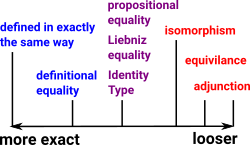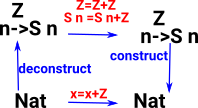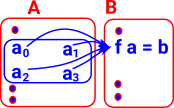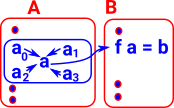On these pages we look equality between terms in a given type. In the context of M-L dependant type theory the distinction between types and terms blurs so we can look at the following as special cases:
- Equality between types.
- Equality between functions.
- Equality between properties (higher order equality).
Equality Of Types
 |
Equality can be defined in different ways, in some cases we need things to be considered equal only when they are defined in exactly the same way, in other cases we need a looser form of equality where things may be defined differently but behave the same in some way. |
Definitional Equality
More exact equality happens when the terms are both defined in exactly the same way. The name 'definitional equality' usually allows the terms to be 'normalised' before comparing them. This means that any functions can be applied to expressions, if this reduces them.
Exactly how this normalisation is done may vary. See page here for more details.
Propositional and Leibniz Equality
Propositional equality considers terms to be equal both when they are definitionaly equal and also when they can be proved to be equal. More information about the nature of these proofs and other details of propositional equality see page here.
Leibniz equality considers terms to be equal when they have the same properties. See page here for more details. Propositional and Leibniz equality amount to the same thing. |

In this diagram P(x) is all properties of x. Every property that is true for x must be true for y. |
This is a useful level of equality for computer languages because types that are propositional equal can be treated the same even though they are not defined identically.
Equality in Computer Code
In 'functional' languages like Haskel and Idris information is held in the form given by its constructors. So, if two types have all identical constructors then they are definitionally equal (internal equality). The eliminators are defined in terms of their properties. So if two types have the same eliminator, for all properties, then they are propositionaly equal (external equality).
Identity or Equality Type
In M-L type theory propositional/Leibniz Equality is represented by a type known as an identity type. This type represents a proposition which is true if inhabited (if it can be constructed).
As with other types 'identity types' are defined by their formation, introduction and elimination rules (see table below). It can be hard to get an intuitive understanding of these rules so the remainder of this page attempts to explain them.
type formation Id exists for every pair of terms in A |
|
||||||
term introduction reflexivity Id is only inhabited if both elements of the |
|
||||||
| term eliminator | from ncatlab:
|
||||||
So lets look at each of these in more detail: (More detail also on this page)
Id Type Formation
We can form any syntactically correct equality as a type, this is called a proposition. These propositions do not have to be true. To 'prove' they are true we construct an instance of them (see term introduction below). |
 |
Id Term Introduction
Propositions have a single constructor called Refl. We can only construct an equality term if it is true. So any proposition can be formed but only true propositions can be constructed. |
Id Term Eliminator
The eliminator tells us how to use a type and it can also tell us what a type 'means'.
In programming a propositional equality between two types allows us to treat the two types interchangeably. Perhaps it is the loosest equality that allows this? How could we express such a conjecture?
If this was true then, given the identity type 'Id', we should be able to construct any other such relationship 'C' because C is always going to be weaker than Id:
|
|
We need to refine that a bit, we cant construct any relationship, C needs to be an equivalence relationship. It turns out that it is sufficient to specify reflectivity then symmetry and transitivity can be implied from that. |
|
||||||
| If we want proofs of these things we need to show these things are inhabited. So 'p' is a proof of Id and 't' is a proof of reflexivity. These proofs are combined to give J(t,p). |
|
||||||
| To specify the implied types and make things more precise the indentity elimination rule is more fully specified something like this: |
|
||||||
By Induction
There are other ways to approach the Id term eliminator. We can look at it as an induction idea. We can use proofs to get more equal terms, then apply proofs to these and so on.
Substitution
| What can we do with an equality type such as x=y? One way is substitution, if we have a property of x denoted P x and we know x=y then we can infer that P y. | (x,y :t) -> (x=y) -> P x -> Py |
| Substitution of like-for-like only works with exact equality, With something looser, such as isomorphism, we can use transport which allows us to transport properties between types. |  |
The items on the bottom are equalities and above them are properties. This shows a substitution in the horizontal direction. When the variable changes the property changes appropriately. |
 |
 |
Having discussed the background we now get to the definition of the eliminator. The eliminator for equality is known as 'J'. It says:
If: ((a:t) -> P a a Refl) then: ((a,b:t) -> (p:a=b) -> P a b p) |
J : (P : (a,b:t) -> (a=b) -> Type) ->
((a:t) -> P a a Refl) ->
((a,b:t) -> (p:a=b) -> P a b p)
J P h a a Refl = h a |
That is, if a property between 'a' and 'a' is true then the same property between 'a' and 'b' is true if a=b.
If we have two variables represented by the same name then we take this as meaning that they are definitionally equal.
If we have two variables 'a=b' then we take this as meaning that they are propositionaly equal (leibniz equality).
So 'J' is saying that definitional equality has the same external properties as Leibniz equality.
Using 'J' we can prove substitution and the equivalence rules (reflexitivity, symmetry and transitivity).
Intuition
As with a lot of powerful mathematical concepts their are multiple ways to understand the equality eliminator:
| As the relationship between propositional and definitionally equality. | |
| As propositional equality = definitionally equality + setoid | |
| As an inductive type | |
Oidification
Oidification allows us to start with a single object and one (or more) arrows back to itself and generalise this to multiple objects. This new structure does not need to have arrows between every pair of objects but composition always exists and every object has an identity arrow.
Here the words 'object' and 'arrow' are used in the category theory sense as described on the page here.
Here are some examples:
| Single Object | Multiple Objects | |
|---|---|---|
|
This imposes an external equivalence relation and internalises it. |
An example would be a set with a set with a fixed number of elements. |
 Since the arrows are reflexive, symmetric and transitive this gives an equivalence relation. |
|
This can be thought of as a weakening of a setiod. Instead of equivalences we have isomorphisms, that is the permutations show how objects are equal in multiple ways. |
 |
|
|
Just to confuse things the naming conventions have changed here. Monoid has an 'oid' but this is the single object case. A Monoidoid is a category. |
 |
 |
Using 'J' Eliminator
Substitution
Refl
Symmetry
Transitivity
Propositional Equality
Propositional equality is effectively the same as Liebniz equality, that is, things are the same if all their properties are the same. Intuitively this makes sense because all the properties can be factored through the constructors/deconstructors. |
 |
Equivalence
There is a more general discussion of equivalence on page here.
Here we are interested in definitions of equivalence that are useful for type theory and especially HoTT.
| One definition (see this paper - definition 2.1.2 ): An equivalence A |
Fiber/Preimage of a Map |
We are given an element of the codomain 'b' and a function from A to B called 'f'. From this there must be an element of the domain 'a' with b = f a.
|
-- The fiber/preimage of a map: fiber (A B : U) (f : A -> B) (b : B) : U = (a : A) * Path B b (f a) (from this site) |
For every element 'b' of 'B' this gives us a set of elements of 'A': In order to define equivalence we need this pre-image to be contractible to a single element. So we need to go on to define contractibility. |
 |
Contractible Type |
We are given a type 'A' For this to be contractible there must be a path from an element 'x' to all 'y'. This is saying that type 'A' must have a unique inhabitant |
-- contractible type
isContr (A : U) : U =
(x : A) * ((y : A) -> Path A x y)
(from this site) |
We can now contract the fibre to give a single element in 'A' to correspond to 'b' in 'B'. So now we have a 1:1 correspondence between 'a' and 'b' so this is looking more like an equivalence. |
 |
Equivalence |
A map is an equivalence if its fibers are contractible | -- A map is an equivalence if -- its fibers are contractible isEquiv (A B : U) (f : A -> B) : U = (b : B) -> isContr (fiber A B f b) (from this site) |
We now have a definition of equivalence in type theory terms. A definition of isomorphism involves finding inverse maps and this does something similar using the pre-image/fibre. However, for this definition of equivalence, we only need to do this in one direction. This is also fairly general in that it is independent of the labels of the elements.
Homotopy Interpretation
If we have two variables 'x' and 'y' they can be considered as two seperate points. These points cannot be compressed into a single point unless x=y.
In HoTT it is possible that x and y can be equal in two different ways so again they cannot be compressed into a single point.



